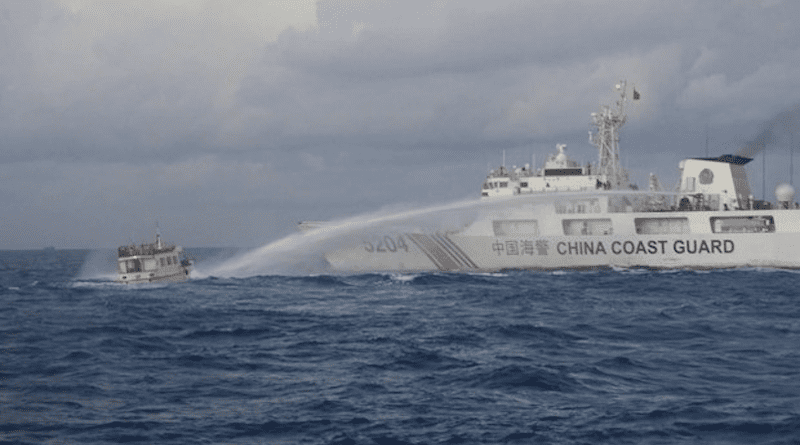Grey Horizons For Beijing’s South China Sea Strategy – Analysis
By Mateusz Chatys
The Second Thomas Shoal has become, alongside the Scarborough Shoal, a main flashpoint of the South China Sea dispute between China and the Philippines. These two geographical features have assumed centrality within China’s strategic initiatives, particularly characterised by its engagement in ‘grey zone’ activities.
These activities feature proxy warfare tactics, demonstrated through coercive measures undertaken by entities such as the China Coast Guard (CCG) and the People’s Armed Forces Maritime Militia. By deploying grey zone tactics, the Beijing administration has strengthened its strategic position in the South China Sea since 2013.
Yet despite the intensified operational endeavours surrounding the Second Thomas Shoal by the Chinese government, tangible achievements remain elusive. It warrants examination of whether China has reached the limit of efficacy within the grey zone.
In 2013, China initiated an expansive campaign of land reclamation to assert and consolidate its territorial claims within the South China Sea. Concurrently, the CCG commenced routine patrols around the Second Thomas Shoal, during which it obstructed Philippine resupply missions to the Philippine Armed Forces outpost on the BRP Sierra Madre.
The Second World War-era ship was intentionally grounded in 1999 as a response to China’s occupation of nearby Mischief Reef in 1994. Due to its location, the outpost requires troop rotation and the replenishment of vital life-sustaining materials. Despite sporadic incidents, the situation was relatively stable. Yet, since 2022, there has been an escalation in CCG and People’s Armed Forces Maritime Militia activities, characterised by increasingly aggressive tactics deployed around the shoal.
The most significant confrontations between Philippine and Chinese vessels occurred in 2023, with five serious incidents recorded. In February 2023, a CCG vessel deployed a military-grade laser on a Philippine vessel supporting a rotation and resupply mission. In August, November and December, the CCG used water cannons against resupply vessels. Collisions between ships also transpired in October and December, stemming from dangerous manoeuvres executed by the CCG.
Amid escalating maritime incidents surrounding the Second Thomas Shoal, tensions in the South China Sea are expected to persistently escalate. Events in the first quarter of 2024 further underscore this trend. In March 2024, two dangerous situations emerged in which the CCG conducted dangerous manoeuvres and used water cannons, resulting in minor injuries to seven crew members on board a Philippine supply vessel.
Despite China’s adoption of aggressive measures in its grey zone activities, the Philippine resupply missions conducted in 2023 and early 2024 were successful. Beijing failed to achieve its objective of severing the BRP Sierra Madre outpost from essential supplies, a scenario that would have facilitated taking control over the Second Thomas Shoal. These developments suggest that Beijing has exhausted its repertoire of measures to deter the Philippines below the threshold of armed conflict.
The effectiveness of limiting China’s grey zone activities is linked to the Philippines’ new tactic of publicising China’s assertive conduct in the South China Sea, beginning in February 2023.
The Philippine government’s systematic documentation and publication of Chinese vessel activities in the South China Sea and collaboration with media outlets have bolstered public support for sovereignty protection measures.
Public disclosure of mission information is crucial. In 2021, only 43 per cent of missions were disclosed compared to 80 per cent in 2023. Public opinion surveys in December 2023 showed 61 per cent support the Ferdinand Marcos Jr administration’s response to the South China Sea dispute, reflecting a sustained increase from previous quarters.
The Philippines’ transparency efforts regarding the South China Sea dispute also advance international objectives, increasing pressure on China. Reports of Philippine encounters with Chinese coercion garner increasing international attention.
The CCG’s use of water cannons against a March 2023 resupply mission prompted special statements from the European Union and several nations. These statements express solidarity with the Philippines, concern over escalating tensions and condemnation of Chinese actions, bolstering Filipino influence internationally.
Chinese activities near the Second Thomas Shoal have not succeeded in enhancing control over the disputed areas of the South China Sea. Instead, Beijing’s approach has deepened public scepticism in the Philippines toward China. According to a 2024 survey, if forced to align with either China or the United States, most Filipinos would align with the United States.
The Philippines has emerged as the foremost supporter of the United States among ASEAN member states for two consecutive years. China’s persistent aggressive actions against the Philippines and Beijing’s hesitance to partake in constructive dialogue or mitigate tensions through mechanisms like hotlines, suggest that the Chinese government is not worried about the declining support of the Filipino public.
Strengthening anti-Chinese sentiments in the Philippines should be regarded as another setback of Beijing’s grey zone tactics. President Ferdinand Marcos Jr has reorientated the Philippine armed forces from internal to external threats. Manila has fortified its ties with the United States and developed bilateral relations with regional stakeholders, including Japan and Australia. It has also deepened collaboration in minilateral formats such as the Philippines–Japan–United States trilateral grouping.
The Philippines’ position has been bolstered. If Beijing escalates with a direct attack, the Chinese government would need to consider invoking the 1951 US–Philippines Mutual Defense Treaty and the involvement of other regional powers, especially Australia and Japan.
- About the author: Mateusz Chatys is a Senior Specialist at the Centre for Asian Affairs, University of Lodz.
- Source: This article was published by East Asia Forum

